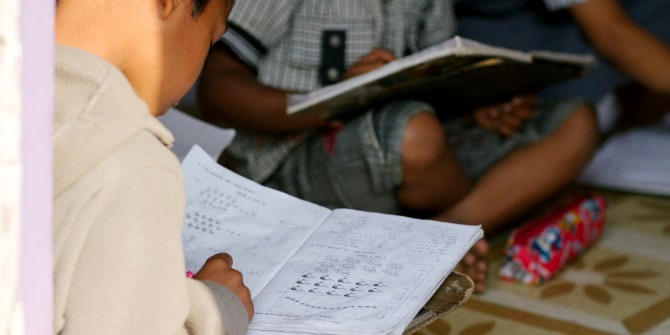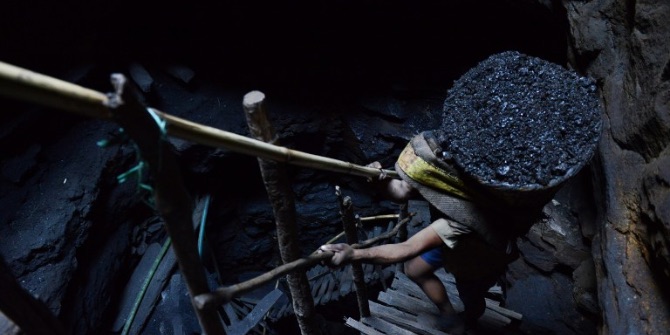In May, Sumathi Ramaswamy visited LSE to talk about the artist M. F. Husain and how his work contributed to the aesthetics of India’s Emergency. After her presentation, she spoke to Sonali Campion about visual history, the challenge of making artwork more widely available, and why Husain is such a controversial artist in India.
Your book The Goddess and the Nation was described as introducing a “different kind of history”. Could you tell me what is meant by this?
The shift was really from the artist to the image – mass produced art was the focus of that book and it actually had images where we didn’t even know the name of the artist. Art is often printed in large quantities and disseminated. We need to think about what kind of work those images are doing, and to see them as not just reflecting but actually constituting history.
I was really building on the work of the anthropologist Chris Pinney who developed the argument about how images are constitutive and are often part of the moment. So in my presentation I talked about M.F. Husain’s Emergency paintings. Yes he’s responding to events, but his creations are part of the moment and part of the history of the Emergency. Conceptually Husain wasn’t only reflecting, he was “co-producing” a vision and an understanding of what was going on.
Does that raise questions about the idea of not being able to contain images in the same way as textual sources, which might be restricted by illiteracy?
The assumption that images are more readily available is true to a certain extent: when I do talks on visual history people will offer comments about the images more readily than when it is a document or text-based presentation. They are harder to contain and they are seen as more dangerous, even in places like India which have iconophilic cultures.
That said, literacy itself has been so defined in terms of the letter and access to the lettered word, whereas you do actually need visual literacy in order to ‘read’ images. And within that, you need different kinds of literacy to read the gallery art that Husain produces, as opposed to the kind of mass produced art that The Goddess and the Nation explored.
As a proponent of visual history, what do you think the barriers are you promoting engagement with images as historical sources?
There is this suspicion about images – scholars have written about how they cannot speak a truth, which is an idea that goes back in the Western philosophical tradition to Plato. This is now written into the teaching of history as a discipline – you said yourself you did a degree in History but had limited encounters with images. The argument becomes that images are the remit of art historians and so on. That’s one set of issues that has to be dealt with.
There is also the problem of who can do this kind of history. It’s actually very expensive to reproduce images: my book The Goddess and the Nation includes 150-odd colour images but that makes it very costly to produce. So only certain scholars and certain privileged institutions who have access to the resources can undertake ambitious visual history projects, which produces an exclusive element that runs contrary to the efforts of the field. I am a historian of India, but I can only produce visual history works sitting in the US in a very privileged institution with ancestral funds and so on, in a way that a counterpart in India who has as much knowledge may not be able to do. Even with the Goddess and the Nation, the Duke University version of it is so beautiful. The Indian edition is not as attractive because of the costs involved
One way around that – and I’m so heartened to see this in the last ten years – is that more and more museums and collections are making their images at least available for free, even if they still charge an arm and a leg for reproduction rights. The digital turn also presents exciting possibilities.
You mentioned that you haven’t seen Husain’s triptych of the Emergency that was the centrepiece of your talk – what were the challenges you faced tracking down his artworks and what can be done to facilitate access?
For me it was to do with the fact I was looking for M. F. Husain images. I’ve got this written this Monograph on him and I’m not sure what’s going to happen to it, because even after his death he’s such a lightning rod in Indian politics. If I’d gone looking for other things they may not have cared. Husain did a lot for the Gandhi family but he’s hated by them now, and his legacy is so contentious.
On a broader level, scholarship itself plays an important role in facilitating access. The more visual scholars do research and show the value of it, the more you get a critical mass which puts pressure on gatekeepers. I do think there’s a move among all scholars to use images, if only in the old fashioned sense of illustration. Museums are beginning to realise it makes no sense to hoard – these images are a public resource, they are there to be shared.
The second thing which has been very useful and good is the digital revolution. I helped create and coordinate a website called Tasveerghar, where we took a vast collection of popular Indian art which is owned by an Indian hotelier and we digitised it all. It’s available for anybody to see.
There’s a real push in other areas of academia to make open access standard so perhaps this is just a few steps behind. And there are others who are trying to make it happen: Google Art for example is open, and many of the big museums now have completely open databases. The challenge is when you come to reproduce it.

Husain lived in self-imposed exile for the last few years of his life, and you have mentioned how hard it has been researching him. Why do you think M. F. Husain is such a controversial artist?
We don’t know for certain, it’s probably a number of factors. The simple answer was that he was a Muslim artist. But then other Muslim artists have been successful so I think it’s tied to the fact that he was a Muslim who dared to speak for the nation. Isn’t he supposed to be quiet, to go along with the narrative created by the majority? Instead he dared to draw and paint for the nation, he was “the nation’s chronicler” as I put it in the book.
I also think the fact he was such a celebrity played a role. Modern art survives in India – and there are more outrageous artworks than Husain’s – but it survives because it only operates in this very narrow world, restricted to people of a certain gallery-going class. Husain on the other hand started out as a working class man, he was a populist and he really took this art to the people. There’s something in that combination that makes him a highly controversial figure, even after his death.
This article gives the views of the author, and not the position of the South Asia @ LSE blog, nor of the London School of Economics. Please read our comments policy before posting.
About the Author
Sumathi Ramaswamy is Professor of History at Duke University. She is a cultural historian of South Asia and the British Empire and her recent research has predominantly focussed on the areas of visual studies, the history of cartography, and gender. Publications in this area include The Goddess and the Nation: Mapping Mother India (Duke University Press, 2010); and two edited volumes, Barefoot Across the Nation: Maqbool Fida Husain and the Idea of India (Routledge, 2010), and Empires of Vision (co-edited with Martin Jay, Duke University Press, 2014). Her pictorial monograph titled Husain’s Raj: Visions of Empire and Nation was published in 2016 by Marg, Mumbai.
Sonali Campion is Communications and Events Officer at the South Asia Centre. She holds a BA (Hons) in History from the University of Oxford and completed her MSc in Comparative Politics at LSE.







